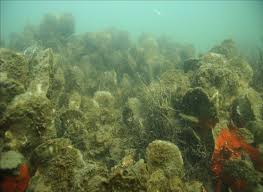If you’ve ever been in the coastal South, you may understand the importance of oysters, but have you ever really listened to them?

The bivalves are not only a favorite food served at almost every restaurant lining the Atlantic for the salty satisfaction of tourists and locals alike, but they are also important to the sound’s natural filtration system — a single oyster can filter up to 50 gallons of water every day. Oysters are also used in living shorelines as a barrier that diffuses wave energy and protects shorelines from erosion. And scientists listening to underwater recordings are discovering that oysters that colonize cultch reefs may also do a lot more.
Supporter Spotlight
In a study summarized in a recent post at North Carolina Sea Grant’s Hook, Line & Science blog, researchers from North Carolina State University explored how fish use cultch reefs, or reefs created by depositing shell and other material in shellfish waters, as habitat. Over a span of two years following restoration, they used underwater sound recordings and traditional methods of netting and trapping fish to measure the diversity and frequency of life in the oyster reef. Their findings showed many diverse species of fish and other aquatic wildlife use oyster reefs as habitat and that underwater recordings are useful in determining which species are present.
It’s not necessarily a groundbreaking concept that fish are hanging out around oyster reefs, but the kind of acoustic recording the researchers used helped them refine previous estimates of fish populations around cultch reefs, because trap-and-net techniques only provided a narrow glimpse of the species living around them.
Other researchers have listened to oyster reefs, before. In a 2013 survey, then-doctoral candidate Ashlee Lillis of N.C. State worked with adviser David Eggleston to discover that free-floating larval oysters relied on sounds emanating from oyster reefs to determine where to land. These baby bivalves prefer to attach to other oysters or similar hard substrate, and the sounds that oyster reefs produce act as a beacon of safe harbor.
“…an ocean reef has very loud, distinct sounds associated with it,” Lillis said in an article published in 2013 on N.C. State’s news site. “Even though oysters don’t have ears and hear like we do, they might be able to sense the vibration from the sounds of the reef.”
An oyster reef’s soundscape is often dominated by fish such as red drum, croaker and perch. The study showed that not only are there more fish than previously estimated, there’s more biodiversity as well, including high numbers of native species. That’s a potential economic boost for the fishing industry.
Supporter Spotlight
Seth Theuerkauf, aquaculture scientist at The Nature Conservancy, said there’s an important balance when it comes to reef fishing.

“Recreational fishing generally does not negatively impact oyster reefs, as it is non-destructive and typically does not impact oysters or the reef structure/habitat,” Theuerkauf said in an email response. “The benefits of enhanced activity draw attention to those reefs and increase their importance to the public.
“… it’s far easier to have support for conservation of existing reefs and restoration of new ones if the general public is able to benefit from their presence in a no- or low-impact way.”
Joel Fodrie, assistant professor at the University of North Carolina Institute of Marine Sciences in Morehead City, said the way fish are always on the move makes it hard to pin down whether reefs produce more fish or simply attract them.

“An individual fish may only use a habitat once in its life, and it might have been very valuable for it, but then it’ll move on,” Fodrie said. “Maybe it’ll come back, and maybe not. We still don’t quite know the answer.”
Matt Kenworthy, a recently graduated doctoral student who worked with Fodrie on a study of fish and cultch reef interactions in the New River estuary, agreed. “These constructed cultch reefs that were designated for oyster enhancement are not necessarily more attractive to the transient species,” he said.
Kenworthy noted that even if reefs just attract, or aggregate, fish, they also provide a permanent home for smaller organisms, too.

“Data might say the more structure you have, you do get more bivalves, you get more worms, you get more crabs and shrimp,” he said. “The things that are more tightly associated with fish structure, you do see more of. Critters seem to be attracted to structure.”
But while oyster restoration sites are being developed, natural oyster reefs are declining. Fodrie said North Carolina had lost 90 to 95% of its oyster reefs, but the number of natural sites still existing far outweigh the number of planted sites.
“What does that mean for fish?” Fodrie asked. “If we’re in a world where we only have 10% of those reefs, do we only have 10% of those species?”
Answering that question may not get any easier, especially with ongoing damage to oyster reefs from certain commercial harvesting practices and the ever-constant movement of fish.
“Oyster harvesting can certainly impact the reef structure, which can have negative impacts on the ability of that area or reef to provide habitat,” Theuerkauf said. “During harvest, if there is not adjacent reef habitat that is not harvested, then yes, there are likely to be substantial negative habitat impacts to fish and invertebrate species.”
Kenworthy said it’s possible to avoid long-term damage to the reef, but it depends on how much reef structure is degraded through the harvesting process. “In the short term there’s going to be a negative effect. The question is: Can that habitat regenerate, or have we removed enough of that hard substrate that new baby oysters cannot then go settle on?”
But providing a structure for fish to shelter in, even if only for an hour before moving on to their next underwater oasis, is a step in the right direction for increased biodiversity — and increased oyster production.
“You have a top-down influence of fish reducing the number of oyster predators or causing oyster predators to not be as active,” Fodrie said.
But the symbiotic relationship isn’t universal.
“Some of the fish, like black drum, like to eat oysters, so they’re eating the things that eat oysters and they’re eating oysters too,” Fodrie added.








